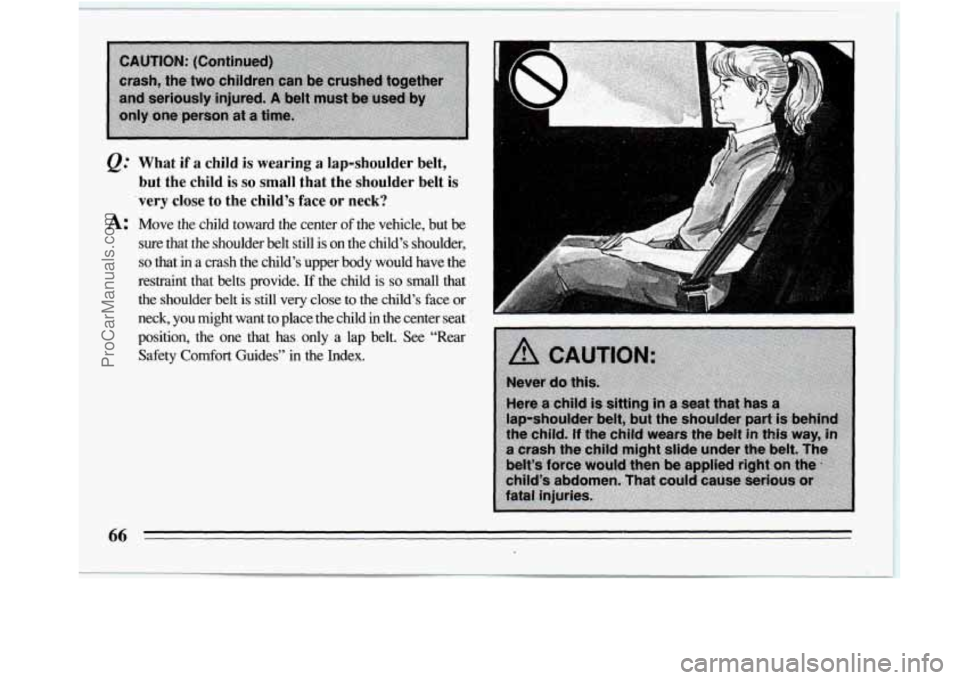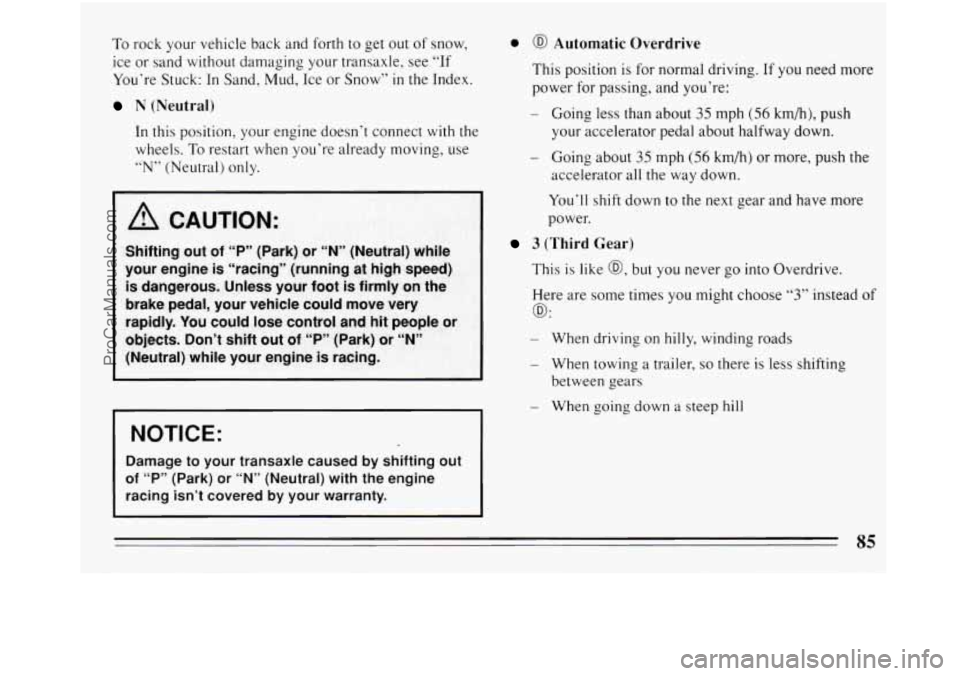1994 BUICK REGAL tow
[x] Cancel search: towPage 20 of 308

Front Seatback Latches (Two-Door Models) Easy Entry $eat (Option-Two Door Models)
The front seatback folds forward to let people get into The rightsfront seat of your vehicle makes it easy to get
the back seat. in and
out
of the rear seat. When you tilt the right front
Your seatback will move back and forth freely, unless seatback fully
,forward, the whole- seat will slide
you come to a sudden stop. Then it will lock in place. forward. After someone gets
into the rear seat area,
move the-right front seatback to its original position.
There’s one time the seatback may not fold without
some help from
you. That’s if your vehicle is parked
going down a fairly steep hill.
I
To fold a seatback forward,
push the seatback toward
the rear as you lift this
latch. Then the seatback
will fold forward. The latch
must
be down for the seat
to work properly. Then move the seat
rearward until it locks. To get out,
again tilt the seatback fully forward.
18
ProCarManuals.com
Page 38 of 308

When is an air bag expected to inflate?
The air bag is designed to inflate in moderate to severe
frontal or near-frontal crashes. The air bag will only
inflate if the velocity of the impact is above the designed
threshold level. When impacting straight into a wall that
does not move or deform,
the threshold level for most
GM vehicles is between 9 and 15 mph (14 and 23
km/h). However, this velocity threshold depends on the
vehicle design and may be several miles-per-hour faster
or slower. In addition, this threshold velocity will be
considerably higher if the vehicle strikes an object such
as a parked car which will move and deform on impact.
The air bag is also not designed
to inflate in rollovers,
side impacts, or rear impacts where the inflation would
provide
no occupant protection benefit.
In any particular crash, the determination of whether
the
air bag should have inflated cannot be based solely on
the level of damage on the vehicle(s). Inflation is
determined by the angle
of the impact and the vehicle’s
deceleration, of which vehicle damage is only one
indication. Repair cost is
not a good indicator of
whether an air bag should have deployed.
What makes an air bag inflate?
In a frontal impact of sufficient severity, the air bag
sensing system detects that
the vehicle is suddenly
stopping as a result of a crash. The sensing system
triggers a chemical reaction of the sodium azide sealed
in the inflator. The reaction produces nitrogen gas,
which inflates the cloth bag. The inflator, cloth bag, and
related hardware are all part of the air bag inflator
module packed inside the steering wheel.
How does an air bag restrain?
In moderate to severe frontal or near-frontal collisions,
even belted occupants can contact the steering wheel.
The air bag supplements the protection provided by
safety belts. Air bags distribute the force of the impact
more evenly over the occupant’s upper body, stopping
the occupant more gradually. But air bags would not
provide protection
in many types of collisions, including
rollovers and rear and side impacts, primarily because
an occupant’s motion is not toward the air bag. Air bags
should never be regarded as anything more than a
supplement to safety belt protection in moderate to
severe frontal and near-frontal collisions.
36
ProCarManuals.com
Page 68 of 308

What if a child is wearing a lap-shoulder belt,
but fhe child is so small that the shoulder belt is
’very close to the child’s face or neck?
A: Move the child toward the center of the vehicle, but be
sure that the shoulder belt still is on the child’s shoulder,
so that in a crash the child’s upper body would have the
restraint that
belts provide. If the child is so small that
the shoulder belt
is still very close to the child’s face or
neck, you might want to place
the child in the center seat
position, the one that has only a lap belt.
See “Rear
Safety Cornfort Guides” in the Index.
ProCarManuals.com
Page 82 of 308

E
With the ignition key in the ignition switch, you can turn
the switch to five different positions.
(A) Accessory: This position lets you use things like the
radio and the windshield wipers when the engine is off.
To
use, push in the key and turn it toward you. Your
steering wheel
will remain locked, just as it was before
you inserted the key.
(B) Lock: Before you put the key in, your ignition will
be in the Lock position. This position locks your
ignition, steering wheel and transaxle. It’s an theft
deterrent feature.
(C) Off: This position lets you turn off the engine but
stili
turn the steering wheel. It doesn’t lock the steering
wheel like “Lock.” Use “Off’
if you must have your car
in motion while the engine is off (example, if your car is
being pushed).
(D) Run: This is the position for driving.
(E) Start: This position starts your engine.
I NOTICE:
If your key seems stuck in “Lock” and you can’t
turn’it, be sure
it is all the way in. If it is, then turn
the steering wheel left and right while you turn
the key hard. But turn the key only with your
hand. Using
a tool to force it could break the key
or the ignition switch. If none of this works, then
your vehicle needs service.
Starting Your Engine
Engines start differently. The 8th digit of your Vehicle
Identification Number (VIN) shows the code letter or
number for your engine. You will find the VIN at the top
left of your instrument panel. (See “Vehicle
Identification Number’’
in the Index.) Follow the proper
steps to start the engine.
80
ProCarManuals.com
Page 83 of 308

Move your shift lever to “P” (Park) or “N” (Neutral).
Your engine won’t start
in any other position -- that’s a
safety feature. To restart when you’re already moving,
use
“N” (Neutral) only.
NOTICE:
--
Don’t try to shift to “P” (Park) if your Buick is
moving. If you do, you could damage the
transaxle. Shift to “P” (Park) only when your
vehicle
is stopped.
To start your 3.1 Liter engine:
1. Without pushing the accelerator pedal, turn your
ignition key
to “Start.” When the engine starts, let go
of the key. The idle speed will go down as your
engine gets warm.
NOTICE:
Holding your key in “Start” for longer than 15
seconds at a time will cause your battery to be
drained much sooner. And the excessive heat
can damage your starter motor.
2. If your engine won’t start (or starts but then stops), it
could be flooded with too much gasoline. Try
pushing your accelerator pedal all the way to the
floor and holding
it there as you hold the key in
“Start” for about three seconds. If the car starts
briefly but then stops again, do the same thing, but
this time keep the pedal down for five or six seconds.
This clears the extra gasoline from the engine.
NOTICE:
Your engine is designed to work with the
electronics
in your vehicle. If you add electrical
parts
or accessories, you could change the way
the fuel injection system operates. Before adding
electrical equipment, check with your dealer. If
you don’t, your engine might not perform
properly.
If you ever have to have your vehicle towed, see
the part of this manual that tells how to do it
without damaging your vehicle. See “Towing
Your Car” in the Index.
81
ProCarManuals.com
Page 87 of 308

To rock your vehicle back and forth to get out of snow,
ice or sand without damaging your transaxle, see “If
You’re Stuck:
In Sand, Mud, Ice or Snow” in the Index.
N (Neutral)
In this position, your engine doesn’t connect with the
wheels.
To restart when you’re already moving, use
“N” (Neutral) only.
I 6% CAUTION:
NOTICE:
Damage to your transaxle caused by shifting out
of “P” (Park) or “N” (Neutral) with the engine
racing isn’t covered by your warranty.
0 @ Automatic Overdrive
This position is for normal driving. If you need more
power for passing, and you’re:
- Going less than about 35 mph (56 km/h), push
your accelerator pedal about halfway down.
- Going about 35 mph (56 km/h) or more, push the
accelerator all the way down.
You’ll shift down to the next gear and have more
power.
3 (Third Gear)
This is like @, but you never go into Overdrive.
Here are some times you might choose
“3” instead of
@:
- When driving on hilly, winding roads
- When towing a trailer, so there is less shifting
between gears
- When going down a steep hill
85
ProCarManuals.com
Page 89 of 308

Parking Brake
To set the parking brake:
Hold the regular brake
pedal
down with your right
foot. Push down
the
paiking brake pedal with yourleft foot.
If the
ignition is on, the brake
system warning light will
come on.
The parking brake uses the brakes on the rear wheels.
To release the parking brake:
This vehicle has a push to release park brake pedal.
Hold
the regular brake pedal down and push the parking
brake pedal with your left foot. This will unlock the
pedal. When you lift your left foot, the park brake pedal
will follow it to the released position.
I NOTICE: 1
Driving with the parking brake on can cause your
rear brakes to overheat. You may have to replace
them, and you could also damage other parts of
your vehicle.
If you are towing a trailer and are parking on any
hill:
See “ Towing a Trailer” in the Index. That section
shows what to do first to keep the trailer from moving.
87
ProCarManuals.com
Page 90 of 308

Steering Column Shift Lever
1. Hold the brake pedal down with your right foot and
set the parking brake.
2. Move the shift lever into “P” (Park) position like
this:
0 Pull the lever toward you.
0 Move the lever up as far as it will go.
3. Move the ignition key to “Lock.”
4. Remove the key and take it with you. If you can
walk away from your vehicle with the ignition key
in
your hand, your vehicle is in “P” (Park).
88
ProCarManuals.com